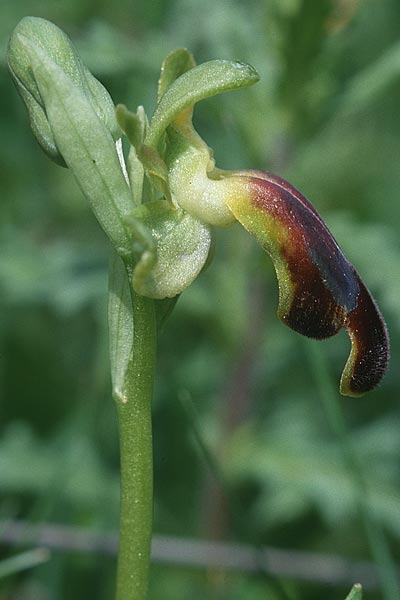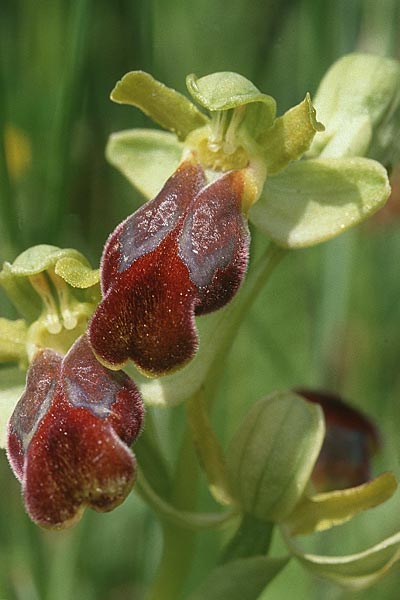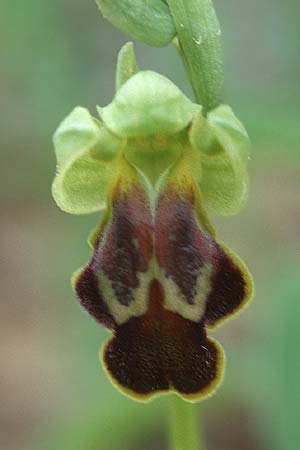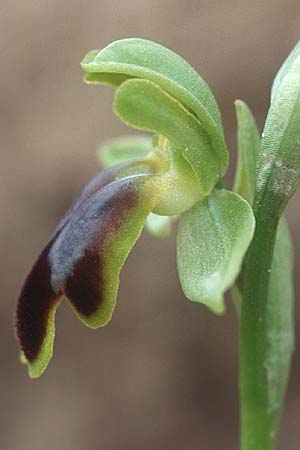In Jber.naturwiss.Ver.Wuppertal 43 (1990): 134 schrieben PAULUS und GACK über eine spät,
das heißt meist erst im April, blühende Ophrys fusca s.l. mit relativ großer Lippe
als weit verbreiteten sizilianischen Endemiten. Leider wurde kein Bild dieser Art veröffentlicht.
Seither wurde sie nach der bestäubenden Sandbiene Andrena trimmerana (der damaligen A. sabulosa sensu WARNCKE)
provisorisch 'sabulosa-fusca' genannt.
2004 veröffentlichte DELFORGE in Natural.belges 85 (Orchid.17): 110-124 eine formelle Beschreibung
einer Ophrys sabulosa, von der er dachte, dass es PAULUS' 'sabulosa-fusca' wäre.
2020 in Jour.Eur.Orch. 52 (2-4): 355ff schrieb PAULUS jedoch, dass dies nicht seine sabulosa-fusca sei,
sondern dass seine sabulosa-fusca die früher blühende Art mit mittelgroßer Lippe sei, die DELFORGE ebenfalls 2004 als Ophrys gackiae
beschrieben hatte. Ophrys gackiae ist nicht hier, sondern dort abgebildet.
DELFORGEs Ophrys sabulosa hingegen, die unten zu sehen ist, sieht aus wie die 1994 beschriebene, im östlichen Mittelmeergebiet und
wahrscheinlich auch in Süditalien vorkommende Ophrys calocaerina.
Ihre Identität ist aber noch nicht bewiesen, denn in Griechenland ist Andrena labiata der Bestäuber der Ophrys calocaerina,
während PAULUS in Sizilien Andrena limbata auf Ophrys sabulosa sah.
In Jber.naturwiss.Ver.Wuppertal 43 (1990): 134 PAULUS and GACK wrote
about a wide spread Ophrys fusca s.l. with relative big lip, which is
late in flower, i.e. usually not before april, and which they considered to be a Sicilian endemism.
Unfortunately no photo of the taxon was published.
Since then it was called by the provisional name 'sabulosa-fusca', which came from
the pollinator, the solitary bee Andrena trimmerana (formerly A. sabulosa sensu WARNCKE).
2004 in Natural.belges 85 (Orchid. 17): 110-124 DELFORGE wrote a formal description
of an Ophrys sabulosa, of which he thought it were PAULUS' sabulosa-fusca.
In 2020 in Jour.Eur.Orch. 52 (2-4): 355ff H.F.PAULUS wrote that it was not his sabulosa-fusca,
but that in reality DELFORGEs Ophrys gackiae also described in 2004 is PAULUS' sabulosa-fusca.
Ophrys gackiae is not shown here but there.
However DELFORGE's Ophrys sabulosa, which is shown below, looks like Ophrys calocaerina
which had been described in 1994 and which is occurring in the Eastern Mediterranean and most probably also in Southern Italy.
But the identity isn't proven yet, because in Greece the pollinating bee of Ophrys calocaerina is Andrena labiata,
while in Sicily PAULUS saw Andrena limbata on Ophrys sabulosa.
|













